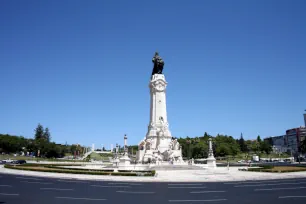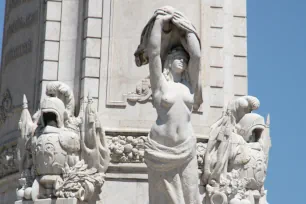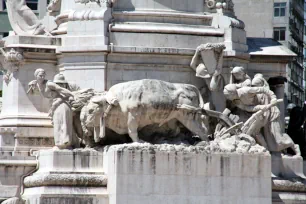At the north end of the Avenida da Liberdade – Lisbon’s main boulevard – is a large traffic junction known as the Praça do Marquês de Pombal (Square of the Marquis of Pombal). At its center stands a tall monument with a statue of the marquis.
The Marquis of Pombal

Sebastião José de Carvalho e Melo, later known as the first Marquis of Pombal, was the prime minister of king Joseph I from 1750 until 1777.
During this time he governed the country almost unchallenged. A supporter of enlightenment, he broke the power of the Jesuits and implemented secular education with a focus on science and mathematics. At the same time he reformed the economy, agriculture, the political system and the administration to improve efficiency and increase Portugal’s competitiveness.


But the marquis may be best known for his efficient and pragmatic handling of the crisis caused by the earthquake and tsunami that ravaged much of Lisbon in 1755. He is famous for his response to the disaster: “What to do? We bury the dead and feed the living.” Thanks to his leadership there was no epidemic outbreak after the earthquake and reconstruction started swiftly.
The marquis himself led the city’s rebuilding efforts, and he decided to raze the downtown buildings in the Baixa district, most of which had been reduced to rubble. Within thirty days after the earthquake, the marquis had drawn up plans for a new modern district with a network of parallel streets leading to a monumental square, the Praça do Comércio. The architecture used during the reconstruction – with anti-seismic features – is known as the Pombaline style.
The Square
The Marquis of Pombal is honored with a large monument at the center of the square that was named after him, the Praça Marquês de Pombal. Despite its name (praça = square), it’s actually more like a roundabout than an actual square.
Heavy traffic makes it difficult to access the roundabout overground but it can be reached via underground tunnels; unfortunately these are often closed. The square is paved with a mosaic pattern that depicts Lisbon’s coat of arms.
Monument to the Marquis of Pombal


The square is dominated by a thirty-six meter (118 ft) tall monument dedicated to the Marquis of Pombal. The monument, built between 1917 and 1934, was the result of a collaborative effort between architects Adães Bermudes and António Couto and sculptors Francisco Santos, Simões de Almeida and his nephew Leopoldo de Almeida.
These artists created a majestic monument that consists of a bronze statue of the marquis standing atop a monumental pedestal. The marquis is looking towards the Baxia district he helped rebuild and is accompanied by a lion, a symbol of power.
Right below the statue are relief busts of his most important collaborators. The pedestal is decorated with sculpture groups that represent institutions that the marquis reformed such as agriculture, industry, politics and education. Rubble and waves at the foot of the monument represent the devastation of the earthquake and tsunami of 1755. Inscriptions on the monument praise the achievements of the Marquis of Pombal.

